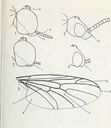Lovebugs
Plecia
Classification
- Phylum: Arthropoda
- Subphylum: Hexapoda
- Class: Insecta
- Order: Diptera
- Infraorder: Bibionomorpha
- Family: Bibionidae
- Genus: Plecia
Pronunciation
How to pronounce Plecia: //ˈpliː.ʃi.ə//
These audio files are automatically generated. While they are not always 100% accurate, they are a good starting point.
Images






Summary
Plecia nearctica, commonly known as the lovebug, is a species of march fly characterized by its habit of flying in copula for days. They are predominantly found along the Gulf Coast and are known for their swarming behavior during mating seasons, making them a nuisance to motorists. Their larvae play a beneficial role in the ecosystem by feeding on decaying matter.
Physical Characteristics
Dark flies with prominent reddish thorax, measuring 13-15 mm.
Identification Tips
Mature pairs join tail-to-tail and hover in the air; often difficult to distinguish from other similar flies.
Habitat
Fields and grassy areas, especially where decaying vegetation is present.
Distribution
Common along the Gulf Coast of the southeastern United States; spread to Florida, Georgia, South Carolina, and some parts of Central America. Also reported in Australia.
Diet
Adults primarily feed on nectar from plants such as sweet clover, goldenrod, and Brazilian pepper. Larvae feed on partially decayed vegetation.
Life Cycle
Life cycle consists of egg, larval, pupal, and adult stages. Females can lay up to 350 eggs, which hatch in 2-4 days. Larvae develop for 120 days during warm months and 240 days during cooler months before pupating for 7-9 days.
Reproduction
Mating occurs immediately after emergence of the females, lasting 2-3 days. Female lovebugs die shortly after laying eggs.
Predators
Birds (e.g., quail and robins), spiders, predatory insects (such as earwigs), beetle larvae, centipedes.
Ecosystem Role
Facilitates decomposition through feeding on decaying vegetation; serves as food for various insectivores.
Economic Impact
Considered a nuisance in automotive contexts as they clog air passages in radiators and can etch car paint due to their acidic body chemistry.
Cultural Significance
Urban legends suggest that lovebugs are genetically engineered, a myth which has been debunked.
Health Concerns
No significant health risks to humans; cannot transmit disease; slightly acidic body may damage car finishes if not cleaned promptly.
Collecting Methods
- Stacking groups of individuals using insect nets during swarming times.
- Trapping using light or bait traps.
Preservation Methods
- Pinning specimens.
- Maintaining in ethanol or isopropyl alcohol for fluid preservation.
Misconceptions
Often thought to be a result of genetic engineering; in reality, they are naturally occurring and migrate.
Tags
- Plecia
- Insect
- Diptera
- Nuisance
- Lovebug